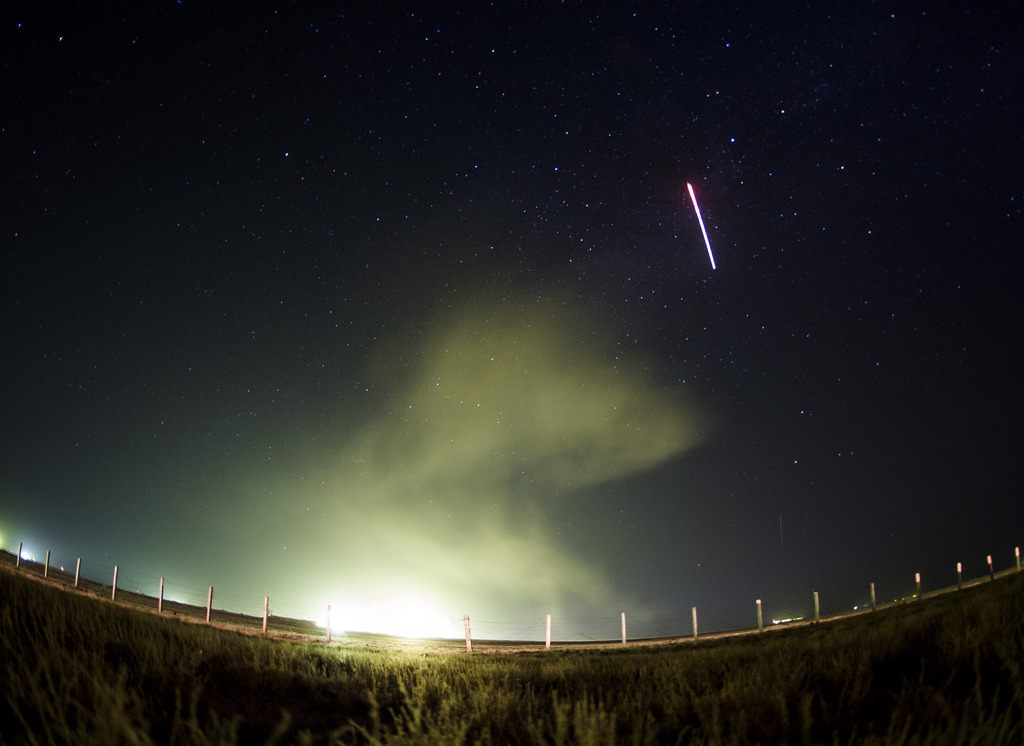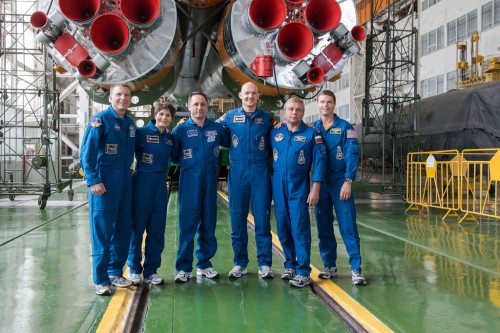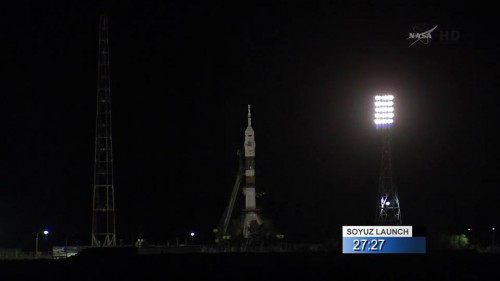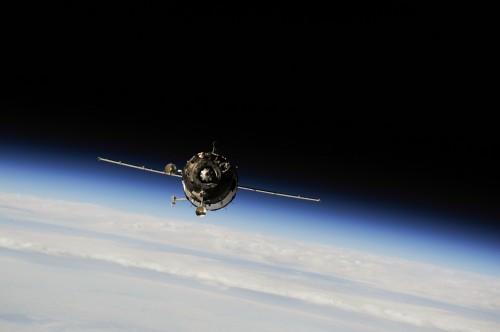
A second sun has risen above the Baikonur Cosmodrome in Kazakhstan, with the rousing launch of Soyuz TMA-13M and three new resident crew members for the International Space Station (ISS). Liftoff occurred precisely on time at historic Site 1/5—the very same location from which Yuri Gagarin began his historic mission, more than 53 years ago—at 1:57:41 a.m. local time Thursday, 29 May (3:57:41 p.m. EDT Wednesday). At the time of writing, Russian cosmonaut Maksim Surayev, NASA astronaut Reid Wiseman, and Germany’s Alexander Gerst are midway through a six-hour, four-orbit “fast rendezvous” profile, in anticipation of a docking at the station’s Earth-facing (or “nadir”) Rassvet module within a time “bracket” up to three minutes either side of 9:48 p.m. EDT Wednesday. They will join the incumbent Expedition 40 crew of NASA astronaut Steve Swanson and Russian cosmonauts Aleksandr Skvortsov and Oleg Artemyev, who have been aboard the orbital outpost since late March.
With the prime crew and their backups—Russian cosmonaut Anton Shkaplerov, NASA astronaut Terry Virts, and Italy’s Samantha Cristoforetti—having journeyed from the Star City cosmonauts’ training center, on the forested outskirts of Moscow, to Baikonur in desolate Kazakhstan, on 15 May, the final preparations for today’s launch have proceeded exceptionally smoothly, in spite of ongoing tensions between Russia and the West over the ongoing strife in Ukraine. As described in yesterday’s AmericaSpace preview story of the mission, the Soyuz-FG booster was rolled horizontally from its assembly building to the launch pad early Monday, 26 May. It was then elevated into a vertical configuration, preparatory to final processing operations. “The Soyuz business end is pointed in the right direction!” quipped NASA Chief Astronaut Bob Behnken in a tweet. Yesterday (Wednesday), the Russian State Commission formally declared that Soyuz TMA-13M was “Go” for launch.
The final hours before each Soyuz launch are laden with symbolism and tradition, as illustrated by yesterday’s blessing of the rocket (and of the assembled media) by a Russian Orthodox priest. Today, Surayev, Wiseman, and Gerst were awakened about 8.5 hours before launch, after which they showered, rubbed down with disinfectant, and enjoyed breakfast, then signed their hotel room doors within the Cosmonaut Hotel. Each man received an Orthodox blessing for their six-month mission ahead. The three men were transported by bus to Site 254 at Baikonur, where they were helped into their “Sokol” (“Falcon”) launch and entry suits. Following standard pressure and leak checks, Surayev, Wiseman, and Gerst spoke briefly to family and friends, before heading out to their final destination on this Earth: Site 1/5 and the Soyuz-FG vehicle which would shortly boost them beyond Earth’s sensible atmosphere and en-route for the ISS.

At 11:15 p.m. local time (1:15 p.m. EDT) Wednesday, Gerst tweeted to his 23,600 followers that he was “In the bus on the way to Gagarin’s launch pad,” adding that “Adrenaline is rising, but feel relaxed.” For his part, Wiseman had already signed off for his 21,300-strong Twitter crowd on Tuesday evening. “Thanks for the amazing support,” he told them. “Time for me to focus on the task at hand. Next tweet will be from space!! Cheers, Reid.” A few minutes after Gerst’s tweet, the three men arrived at the base of the pad and took the elevator up to Soyuz TMA-13M. Meanwhile, Bob Behnken tweeted an image of the rocket on the pad. Captured also in NASA TV imagery, it was an eerie scene, as the three men appeared enveloped in a swirling fog of boiled-off cryogenic gases. With Surayev—the only veteran member of the crew, on his second mission—positioned in the center seat of the bell-shaped descent module, Wiseman took his place on the left side of the cabin and Gerst on the right. Also accompanying them into orbit was a small toy giraffe, hanging in the cabin to provide an indicator of the onset of weightlessness, courtesy of Wiseman’s daughter.
The final two hours of pre-launch preparations ran like clockwork. The rocket transferred to its internal guidance system, and, at T-40 minutes, the servicing tower was retracted, exposing the full beauty of a vehicle which can trace its ancestry back to the world’s first intercontinental ballistic missile, the R-7, conceived in the 1950s. Following the conclusion of fueling with RP-1 and liquid oxygen, the propellant loading entered a “topping mode,” whereby all cryogenic boil-off was rapidly replenished until shortly before launch. This ensured that the liquid oxygen tanks were kept at Flight Ready levels, ahead of the ignition of the first-stage engines. In the last 15 minutes, the Launch Abort System (LAS) was armed and switched to Automatic Mode, and at T-5 minutes Commander Surayev’s controls were activated and the crew were instructed to close their visors. Internal avionics were initiated, and the on-board flight controllers were spooled-up to monitor the rocket’s myriad systems during its ascent to low-Earth orbit.
Inside the control bunker, the “launch key”—an actual, physical key—was inserted at T-5 minutes, effectively enabling the ordnance to support Soyuz TMA-13M’s voyage into space. The final phase of the countdown saw the completion of nitrogen purging, the pressurization of propellant tanks, and the continued topping-off of cryogenics. At T-10 seconds, the turbopumps on the central core of the rocket and the four tapering strap-on boosters awokr and the engines were confirmed at full power. This produced a retraction of the fueling tower and a perfect, on-time liftoff into the darkened Baikonur sky at 1:57:41 a.m. local time Thursday, 29 May (3:57:41 p.m. EDT Wednesday).

Rising rapidly, the vehicle exceeded 1,100 mph (1,770 km/h) within a minute of liftoff, produced a clipped “Flight Nominal” from the Russian-speaking announcer. At T+118 seconds, at an altitude of about 28 miles (45 km), the four tapering boosters exhausted their propellant and were jettisoned, leaving the central core and its single RD-108 engine to continue the boost. By two minutes into the flight, the vehicle was traveling in excess of 3,350 mph (5,390 km/h).
The payload shroud and escape tower fell away shortly afterward, and, about four minutes and 58 seconds after departing Baikonur, the central core separated at an altitude of 105 miles (170 km). At this point, the third and final stage of the Soyuz-FG ignited to boost Surayev, Wiseman, and Gerst to a near-orbital velocity of 13,420 mph (21,600 km/h). By nine minutes into the mission, at 4:07 p.m. EDT, when the third stage finally exhausted its propellant and separated, the crew was officially in space. Aboard Soyuz TMA-13M, the first indication of the peculiar condition, known as “microgravity,” came when Wiseman’s toy giraffe began to comically float, rather than hang, on the end of its cord. According to Spaceflight101, the targeted “insertion orbit” is 124 x 150 miles (200 x 242 km), inclined 51.67 degrees relative to the equator, after which a series of maneuvering “burns” will be performed by the crew to gradually align their craft with the 256 x 259-mile (413 x 417 km) orbit of the ISS itself.
The first burn was scheduled to occur at about 44 minutes after launch. Lasting 92.9 seconds, it was designed to increase Soyuz TMA-13M’s velocity by about 123.1 feet per second (37.54 meters per second) and raising its orbital altitude by about 35.6 miles (57.3 km). Forty-three minutes after the first burn, a second firing—lasting 87.3 seconds—was tasked with imparting an increase in velocity of 117 feet per second (35.67 meters per second) and raising the altitude by another 41.6 miles (67 km).
Three further rendezvous burns will take place a little over two hours into the mission. During the launch of the previous mission, Soyuz TMA-12M on 25 March, a software problem prevented the third burn from taking place, and, by default, the subsequent engine firings were also scrubbed. The mission—which bore the current Expedition 40 crew of Swanson, Skvortsov, and Artemyev into space—reverted to its standard, two-day rendezvous profile and docked successfully at the ISS on 27 March.

Assuming Surayev, Wiseman, and Gerst experience no similar problems, they will set to work on the third and fourth burns whilst over a Russian ground station. “During the first ground station pass, refined parameters for burns 3 and 4 are uplinked to the spacecraft, based on the actual insertion orbit measured shortly after launch,” it was explained by Spaceflight101. “These updates will slightly shift the times of ignition of the burns and also modify the planned delta-V values to target the specific orbit needed for the initiation of the Automated Rendezvous.” The third burn was due to occur at T+2 hours and 4 minutes, delivering Soyuz TMA-13M into an orbit of 210 x 233 miles (338 x 375 km), after which the fourth burn at T+2 hours and 35 minutes would raise their altitude still further and almost circularize it at 223.7 x 233.6 miles (360 x 376 km).
From this circularized orbit, continued Spaceflight101, the Automated Rendezvous Sequence with the ISS will commence at 7:42 p.m. EDT, a little under four hours into the mission. A fifth maneuvering burn will further refine the approach, leading to a flyaround of the station and docking at Rassvet, which is planned to occur within a three-minute “bracket” of time, around 9:48 p.m. EDT. In the aftermath of “Contact and Capture,” a lengthy and complex protocol of pressure and leak checks will be conducted, preparatory to the opening of hatches between Soyuz TMA-13M and the ISS about 90 minutes later. The arrival of Surayev, Wiseman, and Gerst will bring the Expedition 40 crew up to its full, six-man strength. The new arrivals are scheduled to spend 166 days in space, forming the second half of Expedition 40 until 11 September and later the core of Expedition 41, before returning to Earth on 10 November.
Want to keep up-to-date with all things space? Be sure to “Like” AmericaSpace on Facebook and follow us on Twitter: @AmericaSpace



